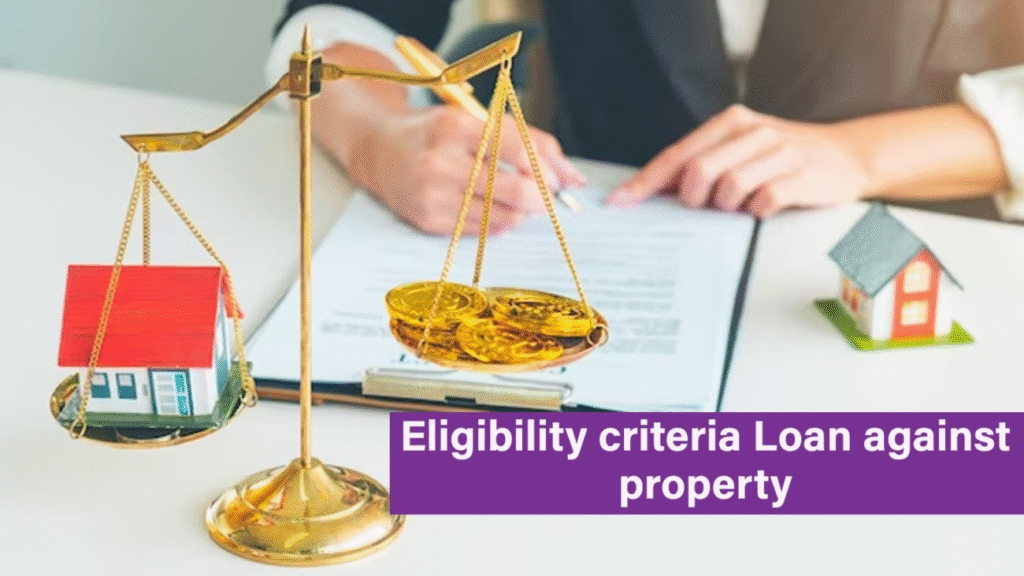In today’s dynamic financial landscape, individuals and businesses often seek avenues to meet substantial financial requirements. One such option is a Loan Against Property (LAP). This secured loan allows borrowers to leverage their property—be it residential, commercial, or industrial—as collateral to secure funds for various purposes.
Key Takeaways
- Secured Loan: LAP is a secured loan where the property serves as collateral.
- Loan Amount: Borrowers can avail themselves of up to 60-70% of the property’s market value.
- Interest Rates: LAPs generally offer lower interest rates compared to unsecured loans.
- Repayment Tenure: Flexible repayment tenures ranging from 5 to 20 years are available.
- No End-Use Restrictions: Funds can be utilized for various purposes without restrictions.
- Tax Benefits: Interest paid may be eligible for tax deductions under specific conditions.
- Risk of Property Loss: Defaulting on the loan can lead to the loss of the pledged property.
Understanding Loan Against Property (LAP)
A Loan Against Property (LAP) is a secured loan where the borrower pledges their property as collateral to obtain a loan from a financial institution. The loan amount sanctioned is typically a percentage of the property’s market value, and the borrower is required to repay the loan in equated monthly installments (EMIs) over a predetermined tenure.
Key Features of LAP
- Loan Amount: Generally, lenders offer up to 60-70% of the property’s market value as the loan amount, subject to assessment and valuation.
- Interest Rates: LAPs usually attract lower interest rates compared to unsecured loans, making them an affordable financing option.
- Repayment Tenure: Flexible repayment tenures ranging from 5 to 20 years are available, depending on the lender’s policies and the borrower’s preference.
- Collateral: The property offered as collateral undergoes a thorough valuation process by the lender to determine its current market value.
How Does a Loan Against Property Work?

The process of obtaining a Loan Against Property involves several steps:
- Application: The borrower submits an application to the lender, providing details about the property and the purpose of the loan.
- Documentation: Necessary documents, including identity proof, address proof, income statements, and property documents, are submitted.
- Property Valuation: The lender conducts a valuation of the property to determine its market value.
- Loan Sanctioning: Based on the property’s valuation and the borrower’s eligibility, the loan amount is sanctioned.
- Disbursement: Upon successful verification and approval, the loan amount is disbursed to the borrower’s account.
- Repayment: The borrower repays the loan in EMIs over the agreed-upon tenure.
Benefits of Loan Against Property
- Lower Interest Rates: Since LAPs are secured loans, they typically offer lower interest rates compared to unsecured loans like personal loans.
- Higher Loan Amount: Borrowers can avail themselves of larger loan amounts, often up to Rs. 5 crore, depending on the property’s value.
- Flexible Tenure: With longer repayment tenures, borrowers can manage their EMIs effectively, reducing financial strain.
- No End-Use Restrictions: LAPs offer flexibility in fund utilization, allowing borrowers to use the loan amount for various purposes such as business expansion, education, medical emergencies, and home renovation.
- Tax Benefits: Under certain conditions, the interest paid on LAPs may be eligible for tax deductions under sections 24(b) and 37(1) of the Income Tax Act, 1961.
- Retain Property Ownership: Borrowers can continue to own and use their property while availing themselves of the loan.
- Quick Processing: The application and approval process for LAPs is relatively quicker compared to unsecured loans.
Types of Loan Against Property
While the general concept of a Loan Against Property is consistent, it can be classified into different categories depending on the type of property used as collateral, the purpose of the loan, and the profile of the borrower. Let’s explore these variations:
1. Residential Loan Against Property
This is the most common form of LAP, where an individual pledges their residential property (house, flat, etc.) to secure a loan. These loans are typically used for personal purposes, such as funding higher education, medical emergencies, or home renovations.
Example:
A person owns a flat in a metropolitan city valued at ₹1 crore. They need ₹50 lakhs to fund their child’s overseas education. In this case, the individual can pledge their flat to the bank for the required loan amount. The bank might sanction around 60% of the property’s value, i.e., ₹60 lakh, after assessing the borrower’s eligibility and the property’s current market value.
2. Commercial Loan Against Property
This type of loan is available to individuals or businesses who wish to pledge commercial properties (such as offices, factories, or shops) for financial purposes. These loans are commonly sought for business expansions, working capital needs, or investment in new ventures.
Example:
A small business owner operates a retail store that owns a commercial property worth ₹5 crore. To expand their operations, they seek ₹3 crore in funding from a bank. The commercial property is pledged as collateral, and the bank offers the loan based on the asset’s value, with suitable terms for the business’s repayment capacity.
3. Industrial Loan Against Property
In this case, an industrial unit or factory is pledged to obtain financing. This type of loan is ideal for businesses looking for capital to purchase machinery, expand production capacity, or invest in infrastructure.
Example:
A factory owner needs funds to buy new machinery worth ₹1.5 crore. Their factory, which is valued at ₹4 crore, can be used as collateral to secure a loan. By pledging the industrial property, the business owner can avail themselves of a loan amount of up to ₹2.5 crore (subject to the lender’s policies).
4. Agricultural Loan Against Property
In some cases, agricultural land can be pledged as collateral for securing a loan. This is useful for farmers and agricultural entrepreneurs who require funds for buying equipment, seeds, fertilizers, or other operational needs.
Example:
A farmer owning agricultural land worth ₹20 lakh can pledge the land to get a loan for acquiring advanced irrigation systems or expanding their farming operations. Such loans may have lower interest rates due to government subsidies in certain regions.
Eligibility Criteria for Loan Against Property

To be eligible for a Loan Against Property, both the property and the borrower need to meet certain requirements. Lenders typically evaluate factors like the value of the property, the borrower’s income, credit score, and repayment history before granting approval.
1. For Individuals
- Age: Borrowers should be between 21 to 60 years of age at the time of loan maturity.
- Income: The borrower must have a stable source of income, whether salaried or self-employed. Lenders often have a minimum income requirement.
- Credit Score: A good credit score (usually 650 or above) is crucial to secure favorable loan terms. A higher credit score helps in negotiating better interest rates.
- Property Title: The property should have clear and marketable titles, with no legal encumbrances.
- Property Ownership: The borrower should be the rightful owner of the property, with the necessary ownership documents.
2. For Businesses
- Business Stability: The business should have a proven track record and demonstrate stability with consistent revenue generation.
- Ownership of Property: The business must own the commercial or industrial property that will be pledged.
- Business Financials: Lenders typically require the business to provide financial statements, balance sheets, and income tax returns for the last 2–3 years to assess the company’s repayment capability.
Interest Rates on Loan Against Property
One of the primary benefits of a Loan Against Property is the relatively lower interest rates compared to unsecured loans. The interest rate is determined by several factors, including the type of property, the loan amount, the tenure, and the borrower’s credit profile.
Interest Rate Range
- Personal Loan Against Property: 10% to 14% per annum
- Commercial Loan Against Property: 10% to 18% per annum
- Loan Against Agricultural Land: 8% to 12% per annum
Typically, financial institutions offer lower interest rates for residential properties compared to commercial or industrial properties due to their comparatively stable market value.
Fixed vs. Floating Interest Rates
Some lenders provide fixed interest rates, where the rate remains constant throughout the loan tenure, while others offer floating interest rates, where the rate can change periodically based on market conditions. A floating rate might be more economical in the long run, depending on interest rate fluctuations.
Risks and Drawbacks of Loan Against Property

While a Loan Against Property offers numerous benefits, it is essential to understand the potential risks before proceeding.
1. Risk of Property Loss
The most significant risk associated with LAP is the possibility of losing your property if you default on the loan. If the borrower fails to meet their repayment obligations, the lender has the legal right to seize and auction the property to recover the outstanding loan amount.
2. Longer Repayment Tenure
While longer repayment tenures provide flexibility, they also mean that borrowers might end up paying more interest over the life of the loan. It’s crucial to calculate the total repayment amount and ensure that it fits within your financial capacity.
3. Valuation Risks
The loan amount depends heavily on the property’s market value, which can fluctuate over time due to market conditions. In a situation where property values decline, the lender may reduce the loan amount or increase collateral requirements, putting the borrower at a disadvantage.
4. High Processing Fees
Banks and financial institutions charge processing fees that can range from 1% to 3% of the loan amount. While these fees are typically non-refundable, borrowers should factor them into the overall cost of the loan.
How to Maximize Your Loan Against Property
To ensure you get the best deal when opting for a Loan Against Property, here are some tips that could help:
1. Compare Lenders
Before making a decision, compare interest rates, loan amounts, repayment terms, and other factors across multiple lenders. Utilize online loan comparison platforms to assess the best options available.
2. Improve Your Credit Score
A higher credit score will help secure better interest rates and loan terms. Ensure you pay off any outstanding debts and maintain a good credit history before applying.
3. Consider the Loan-to-Value (LTV) Ratio
The LTV ratio determines how much of your property’s value the lender is willing to offer as a loan. A higher LTV ratio means a larger loan, but it also increases the risk for the lender. Aim for an optimal LTV ratio to balance loan amount and interest rates.
4. Opt for Shorter Tenures
Although longer repayment tenures provide flexibility, they lead to higher overall interest payments. Consider opting for a shorter tenure, which would reduce the total interest outgo, provided your monthly EMIs are manageable.
Also Read :-What Is A Debt Consolidation Loan and How Can It Help You?
Conclusion
A Loan Against Property is a valuable financial tool that allows individuals and businesses to leverage their property to meet significant financial needs. With its lower interest rates, higher loan amounts, and flexible repayment tenures, LAPs offer a viable alternative to unsecured loans. However, it’s crucial to understand the terms and conditions, including the risks involved, before proceeding.
Frequently Asked Questions (FAQs)
1. What types of properties can be pledged for a Loan Against Property?
Both residential and commercial properties can be pledged as collateral for a LAP. The property should be free from legal disputes and encumbrances.
2. Can a self-employed individual avail a Loan Against Property?
Yes, self-employed individuals can avail themselves of LAPs, provided they meet the lender’s eligibility criteria and submit the necessary documentation.
3. Is the loan amount based on the property’s market value or the purchase value?
The loan amount is typically based on the current market value of the property, determined through a professional valuation process.
4. What happens if I default on the loan repayment?
In case of default, the lender has the right to take possession of the mortgaged property to recover the outstanding loan amount.
5. Can I prepay the loan without penalties?
Many lenders offer the option of prepayment without penalties; however, it’s advisable to check with the specific lender for their prepayment policies.
6. Is there a maximum age limit for loan repayment?
The maximum age limit for loan repayment varies among lenders. Typically, the loan tenure should conclude before the borrower’s retirement age.
7. Are there any processing fees associated with LAPs?
Yes, lenders charge processing fees, which can vary. It’s essential to inquire about these fees before applying.
